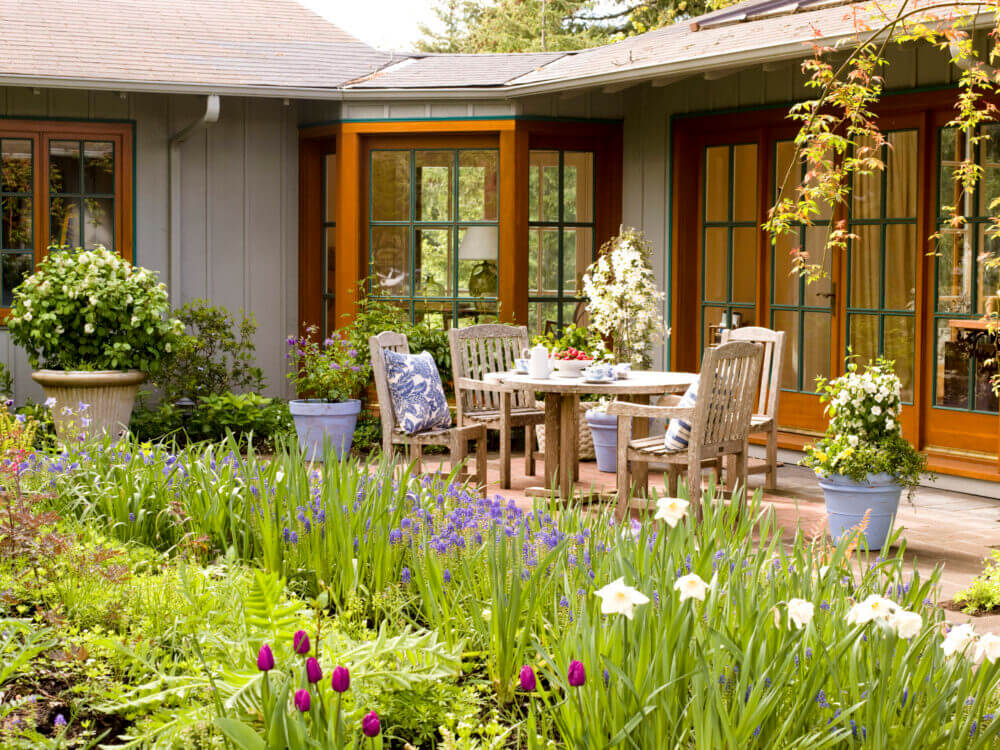If you’ve never tackled landscape design before, you might be overwhelmed by all the choices. But the same principles that guide room setup inside should guide your designs outside, too. Here are seven landscape design tips to get you started.
Determine landscape needs and wants.
Make a list of needs and wants. Do you need a play space for kids? Do you want to grow vegetables? Would your family gather on a patio? Create some rough sketches of the yard, noting where you want to place things; it’s a great organizing principle for landscape design. “These aren’t master plans, just ideas,” says Marianne Lipanovich, author of the Big Book of Garden Designs. “The one I did for our front-yard overhaul was literally a few lines and a couple of circles, but my husband understood the plan, and we went ahead with formal planning out on the site. You can easily play around with ideas without a lot of time and commitment.”
Think about location.
Study the sun and wind patterns. You might want to place a patio on the west side of the house, but it will get lots of afternoon sun, which means dinnertime in August won’t be relaxing—just hot. And wind whistling around a corner will quickly extinguish a fire pit. Your design should take into account what the sun and wind do at different times of the day and year. “You’ll need solutions to temper the problem,” Lipanovich says.

Sit down and enjoy your landscape.
Live with it for a while. Coming to quick conclusions about your yard can lead to choices that don’t work in the long term. “In our yard, there are certain areas where you want to go and sit that I wouldn’t have thought of when we first bought it,” Lipanovich says.

Start small.
Home and garden television shows are masters at revealing complete outdoor makeovers in just three days—but they have a crew of 60 to make that work. Part of creating a landscape is slowly developing a plan and enjoying the process. From your master plan, start with a small flower bed. Go out and work on it for an hour or two when you have the time, and worry less about filing everything up right away. “Give yourself some time to see how things develop. Plants grow and things fill in, and people forget that. The point is to take time and do it in pieces so you are happy with the final results,” Lipanovich says. “If you get into this thing and want to get it done, you’ll take shortcuts and be too sloppy and tired to do it well.”
Find a focal point.
Any good garden design has a focal point or series of focal points. That may be a sculpture or a stunning plant, a tree or a series of shrubs. “The point is to draw your eye and move it through the landscape,” Lipanovich says.

Focus on scale and pacing.
It’s the trickiest principle in landscape design, but scale and pacing give your yard a pulled-together look. There will be variations in size, shape and color, with tall plants against a building or in the back of a flower bed, and paths that lead people through the space. “You’ll want to repeat some elements, whether it’s a certain plant, a common color or even a shape, so there’s a sense of cohesion,” Lipanovich says. “But you also don’t want it to be monotonous, so try adding an occasional element that’s different from the landscape and will stand out.”
Be open to change.
Unless you’re strongly devoted to something, be honest about what you like—and what may fall out of favor. “I find myself over the years discovering that I really liked one thing and that it now no longer reflects me, so I take it out,” Lipanovich says.
Patience is key in landscape design. If all of that bare space is too much to look at, and the kids and dogs are tracking in mud, rely on temporary solutions—annuals, fast-growing ground covers, even mulch—to cover an area while you’re figuring out what you want. “Large landscaping features like trees can be hard to move; annuals can be taken out, and small perennials and shrubs can be transplanted if you realize they’re in the wrong spot. But in the meantime, you have something out there,” Lipanovich says.
© Meredith Corporation. All rights reserved. Used with permission.







